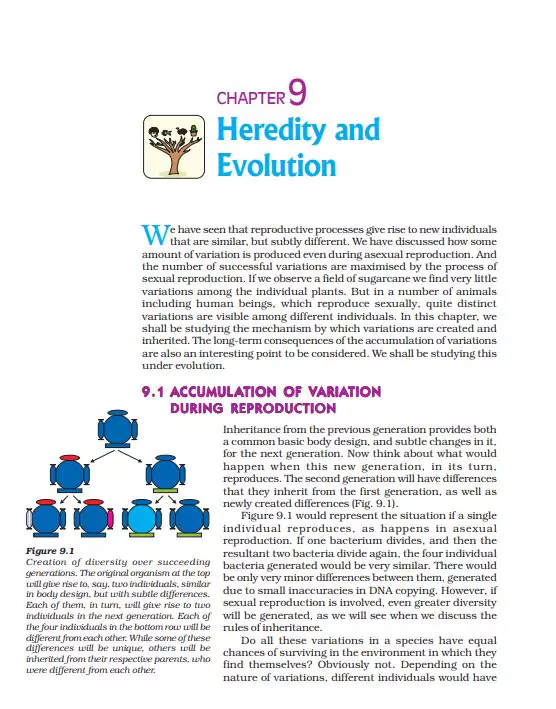‘Heredity and Evolution Notes’ PDF Quick download link is given at the bottom of this article. You can see the PDF demo, size of the PDF, page numbers, and direct download Free PDF of ‘CBSE Class 10 Science Chapter 9 Heredity And Evolution Notes’ using the download button.
CBSE Class 10 Science Chapter 9 Heredity And Evolution Notes PDF Free Download

Class 10 Science Chapter 9 Heredity and Evolution Notes
Some important terms
1. Chromosomes are long thread-like structures present in the nucleus of a cell that contains hereditary information about the cell in the form of genes.
2. DNA is a chemical in the chromosome which carries the traits in a coded form.
3. Gene is part of a chromosome that controls a specific biological function.
4. Contrasting characters: A pair of visible characters such as tall and dwarf, white and violet flowers, round and wrinkled seeds, green and yellow seeds, etc.
5. Dominant trait: The character which expresses itself in an (Ft) generation is the dominant trait. Example: Tallness is a dominant character in pea plants.
6. Recessive trait: The character which does not express itself but is present in a generation is a recessive trait. Ex. dwarfism in the pea plant.
7. Homozygous: A condition in which both the genes of the same type are present for example; an organism has both the genes for tallness it is expressed as TT and genes for dwarfness are written as tt.
8. Heterozygous: A condition in which both the genes are of different types for example; an organism has genes Tt it means it has a gene for tallness and the other for dwarfness only a tall character is expressed.
9. Genotype: It is the genetic makeup of an individual for example; A pure tall plant is expressed as TT and hybrid tall as Tt.
10. Phenotype: It is the external appearance of the organism for example; a plant having Tt composition will appear tall although it has the gene for dwarfness.
11. Homologous pair of characters are those in which one member is contributed by the father and the other member by the mother and both have genes for the same character at the same position.
Monohybrid Cross
- When only one character is considered while crossing two organisms, then such a cross is known as a monohybrid cross.
- The ratio of characters arising out of this cross at F2 generation is called the monohybrid ratio.
- E.g., If a tall plant (TT) is crossed with a dwarf plant (tt), we get 3 tall:1 short plant at the end of the F2 generation.
- So, 3:1 is a monohybrid ratio.
- Here, the height of the plant is considered at a time.
Below is an example of a monohybrid cross between a true-breeding pea plant with green pods (GG) and yellow pods (gg). Here, the green color of the pod is the dominant trait. Hence, in the F1 generation, all plants contain green pea pods.
| Language | English |
| No. of Pages | 18 |
| PDF Size | 2.9 MB |
| Category | Education |
| Source/Credits | ncert.nic.in |
Related PDFs
Democracy And Education PDF By John Dewey In English
Bholi Class 10 Questions And Answers PDF
Weather, Climate, And Adaptations Of Animals To Climate Class 7 Science Notes Chapter 7 PDF
Silk Road Class 11 Questions And Answers PDF
CBSE Class 10 Science Chapter 9 Heredity And Evolution Notes PDF Free Download
